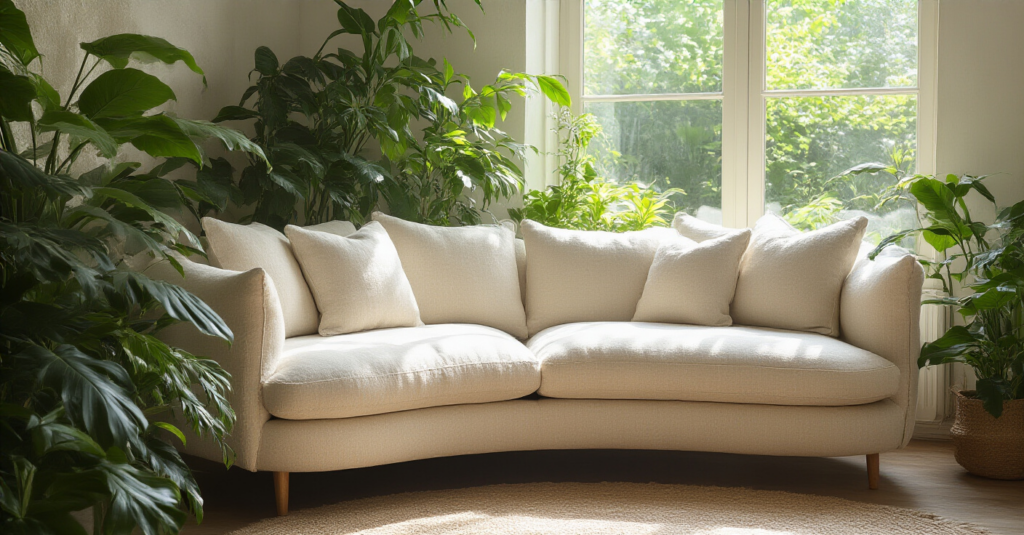Designing a home is fundamentally an act of self-care—every choice reflects not just aesthetic preference, but deeper values about how life should be lived to support our well-being. The most compelling interiors aren’t decorated; they’re authored. They tell a coherent story about who we are and what we need to feel restored. And no piece of furniture tells a more central story than the one we retreat to for comfort, connection, and rest.
As the heart of the home, your living room couch should be more than a visual statement; it must be an active contributor to your health and happiness. My work in wellness design consistently shows that the details we often overlook—from the fibers we sit on to the couch’s position relative to the morning sun—profoundly impact our physical vitality and mental peace. These 20 principles are designed to move beyond the superficial, guiding you to select a piece that truly nurtures. We’ll explore ergonomic foundations, the vital importance of non-toxic materials, and the art of mindful placement, transforming your approach and empowering you to create a genuine haven.
The Ergonomics of Serenity: Establishing Foundational Well-being (Part 1)
Before we can even think about fabrics and colors, we must start with the body. A truly health-affirming couch is one that supports our physical form, allowing for true rest and recovery. This initial exploration focuses on the essential ergonomic principles that lay the groundwork for a serene and restorative space.
1. Deconstructing the Couch’s Role in Biophilic Design Principles for Interior Harmony
At its core, wellness design recognizes our deep, innate connection to nature—a principle we call biophilia. This isn’t just about adding houseplants; it’s a philosophical anchor for creating restorative spaces. Applied to your living room couch, biophilic design means consciously choosing forms, materials, and patterns that echo the natural world, subtly reducing stress and fostering a sense of calm. Think of a frame made from solid, sustainably-sourced wood, upholstery in organic linen or wool, or a color palette drawn from a forest floor or a misty coastline.
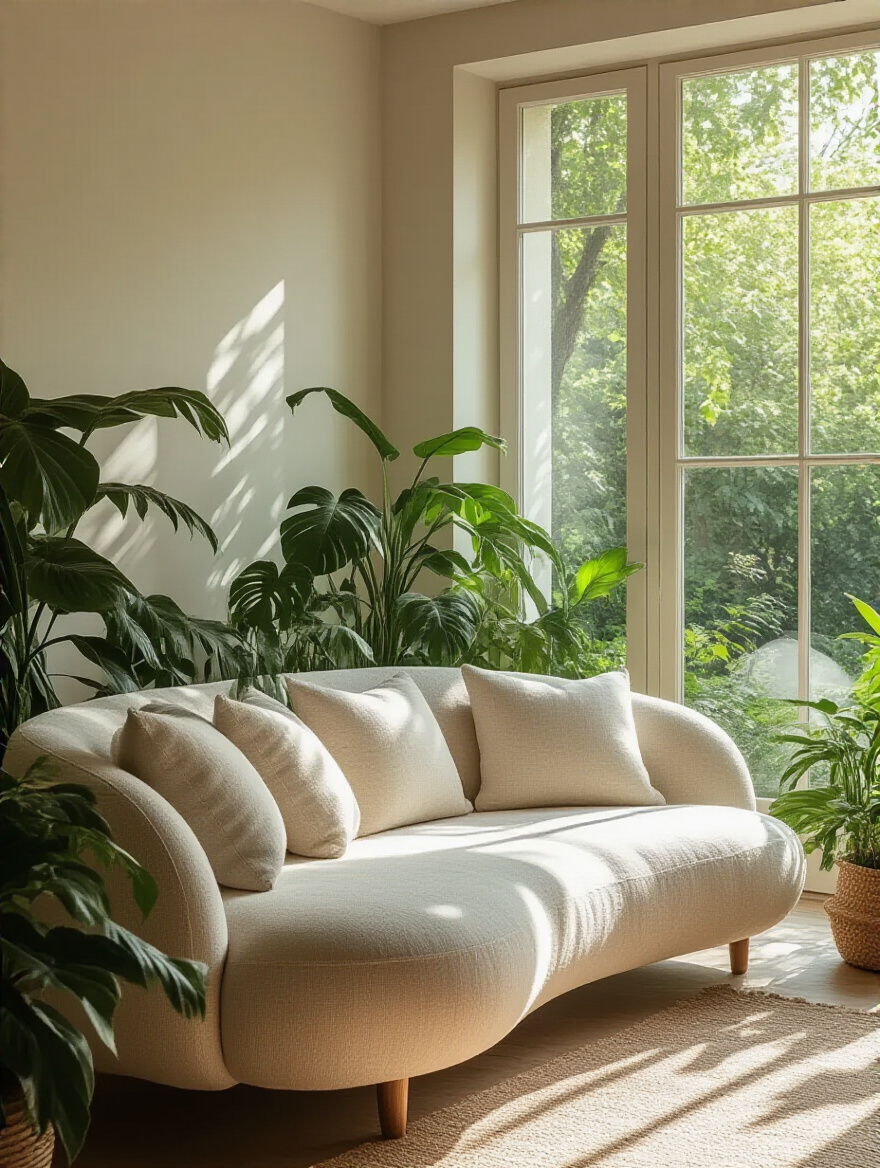
This philosophy extends to the very shape of the furniture. Curves that mimic natural forms, asymmetrical profiles, and textures that invite touch can mitigate the hard, straight lines common in modern interiors. In my wellness design consultant practice, I often guide clients to position their couch to maximize natural light or to provide a calming view of a garden. This isn’t just about the view; it’s about creating a sense of refuge, a safe harbor akin to a natural alcove. This transforms a simple piece of furniture into a conduit for quiet reconnection with the world outside your window.
2. Performing an Experiential Audit: Mapping Current Couch Functionality to Wellness Metrics
Before you can choose the right new piece, you have to honestly assess the one you have now. An experiential audit is a critical first step. It’s about moving beyond “it’s uncomfortable” to systematically map how your current living room couch supports—or undermines—your well-being. How do you feel after an hour spent reading on it? Is there a subtle tension in your neck or lower back? Does the fabric feel irritating against your skin?
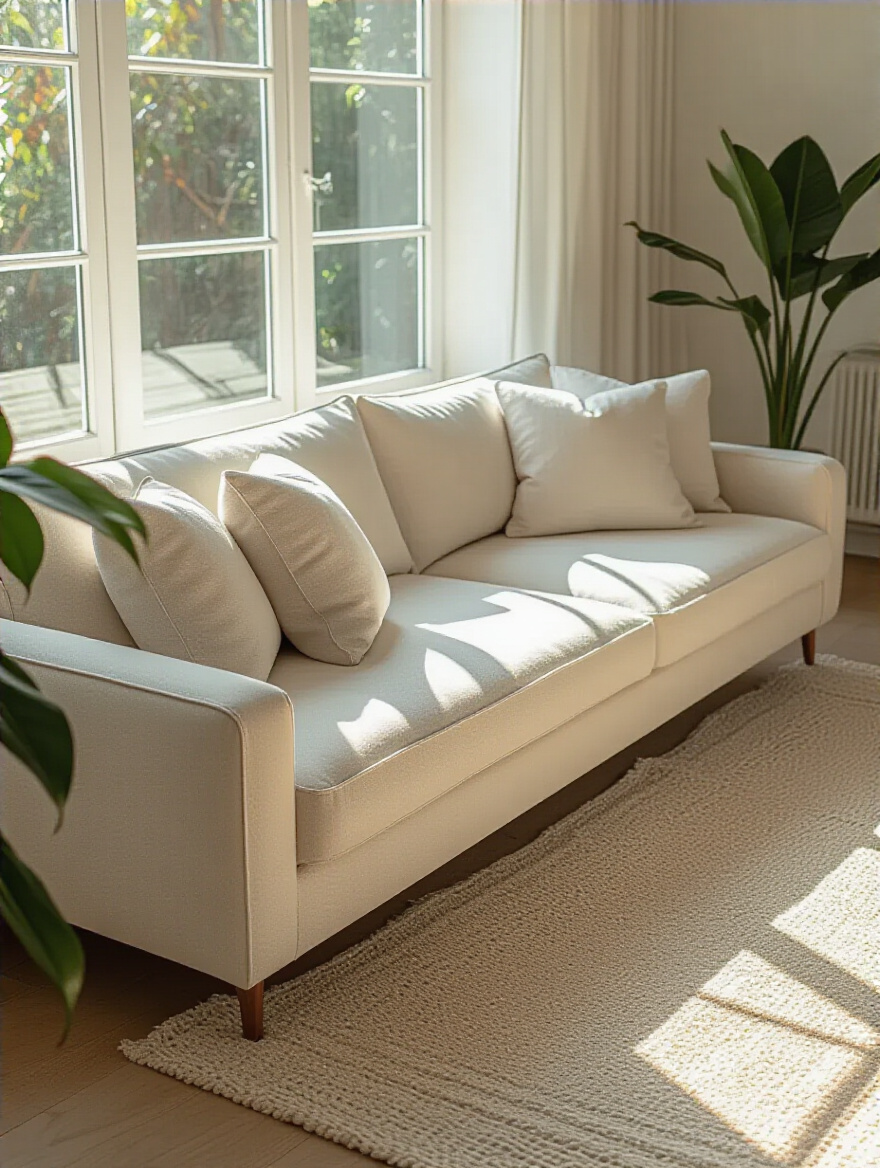
Take a week and be a detective in your own home. Notice your body language. Are you constantly shifting, propping yourself up with extra pillows? Does getting up feel like an effort? The material itself could be an issue; perhaps the foam has degraded, or the synthetic fabric is off-gassing subtle irritants. By observing what isn’t working, you create a precise blueprint for what your new living room couch must provide to align with a healthier, more mindful way of living.
3. Quantifying Personal Anthropometrics: Tailoring Couch Dimensions for Optimal Ergonomic Alignment
Here’s a truth that grounds all my work in wellness architecture: furniture must be designed to fit the human body, not the other way around. This calls for quantifying your personal anthropometrics—a scientific-sounding term for the simple act of measuring your body to find the perfect fit. So many issues with chronic pain stem from poorly-fitting furniture that forces our bodies into stressful postures day after day.
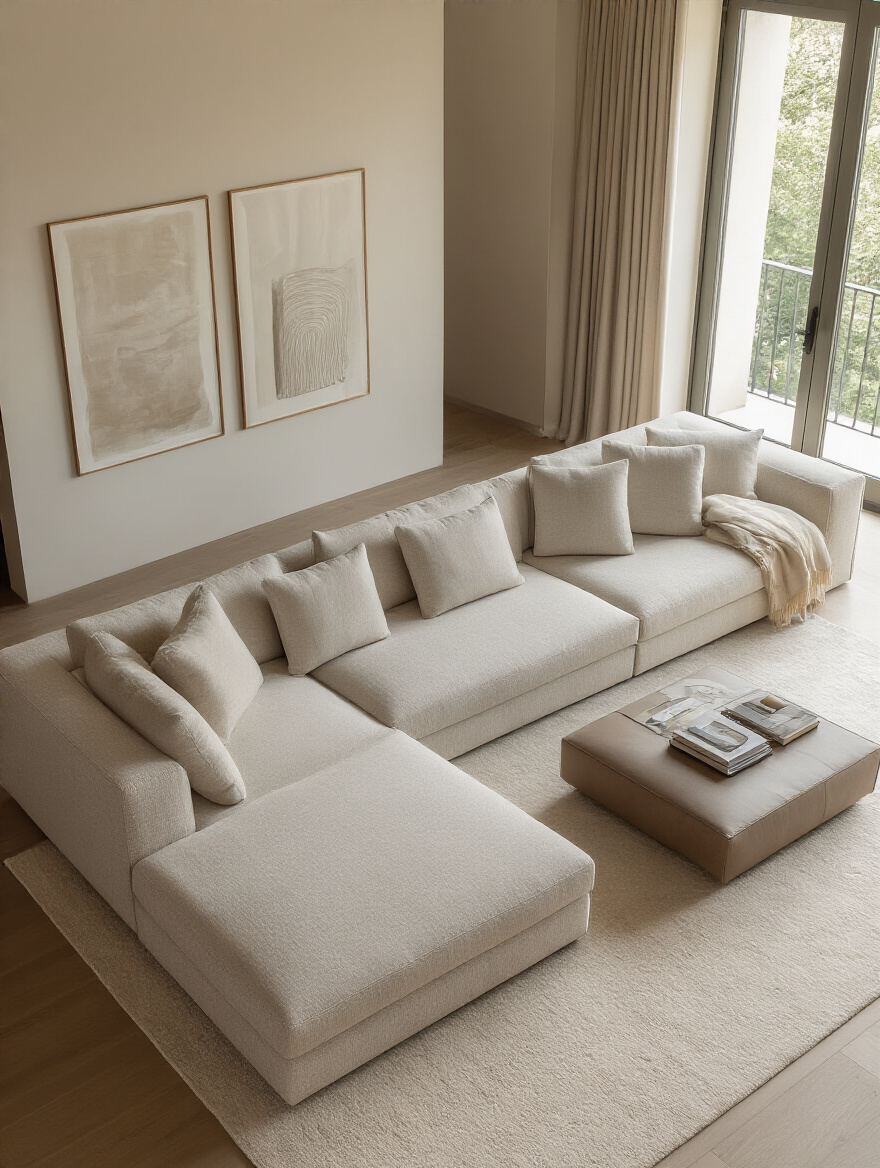
This is where you get out the measuring tape. For ideal seat height, your feet should rest flat on the floor with your knees at a 90-degree angle. For seat depth, you should be able to sit all the way back, fully supported, without the edge of the cushion pressing into the back of your knees. Armrest height is just as crucial—it should allow your shoulders to remain relaxed, not hunched up. Aligning these simple measurements with a sofa’s specifications moves you from guesswork to a tailored choice that actively promotes postural integrity and allows your body to truly rest.
4. Navigating Lumbar-Pelvic Support Mechanisms: A Critical Assessment for Sustained Postural Integrity
The relationship between your lower back and pelvis while seated is the bedrock of postural health. An effective living room couch must provide nuanced lumbar-pelvic support. Inside the couch, the spring system—be it sinuous springs or the gold-standard eight-way hand-tied coils—dictates the resilience and support of the seat. High-resilience (HR) foam provides a firm, supportive foundation, while an integrated lumbar curve in the backrest encourages the natural ‘S’ shape of the spine.
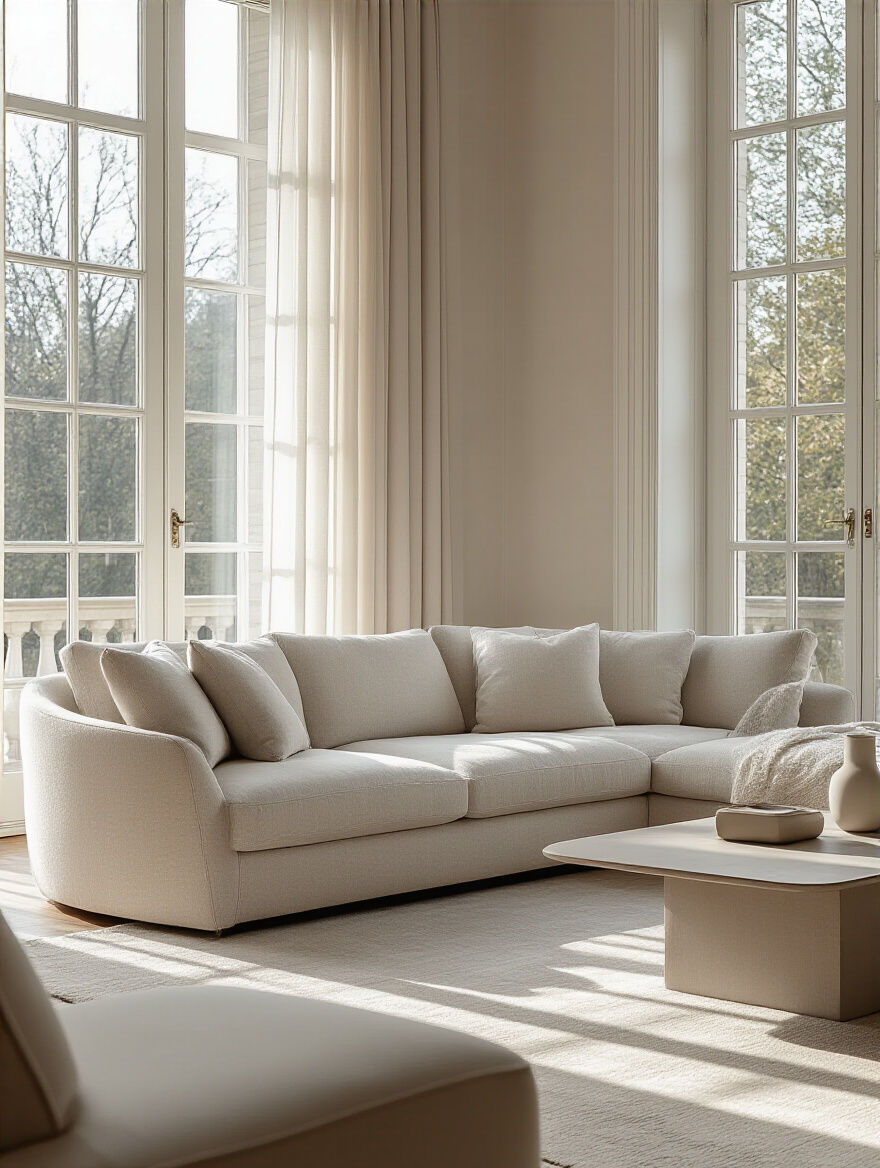
This isn’t just about avoiding back pain. When your pelvis is stabilized in a neutral position, your entire posture improves, promoting better circulation and reducing cumulative fatigue. I’ve noticed clients often mistake initial “sink-in” softness for true comfort, only to find it leads to discomfort over time. A couch with proper support shouldn’t feel rigid, but it should feel like it’s holding you with intention. This transforms your seating from a place of passive slouching into a restorative zone for long-term physical well-being.
The Ergonomics of Serenity: Establishing Foundational Well-being (Part 2)
Building on physical comfort, we now turn to the subtle environmental forces that shape our tranquility. A truly holistic approach considers how our homes can align with our natural biological rhythms, turning a living space into a sanctuary that works with, not against, our internal clocks.
5. Implementing Circadian Rhythm Integration: Strategic Placement for Light Exposure and Melatonin Regulation
Our bodies are beautifully attuned to the 24-hour cycle of light and darkness. This internal clock, our circadian rhythm, governs everything from sleep quality to mood. One of the most powerful things we can do in our homes is to design them in a way that supports this natural rhythm. And yes, this includes where you place your living room couch. It’s not just a decorating choice; it’s a profound commitment to physiological alignment.
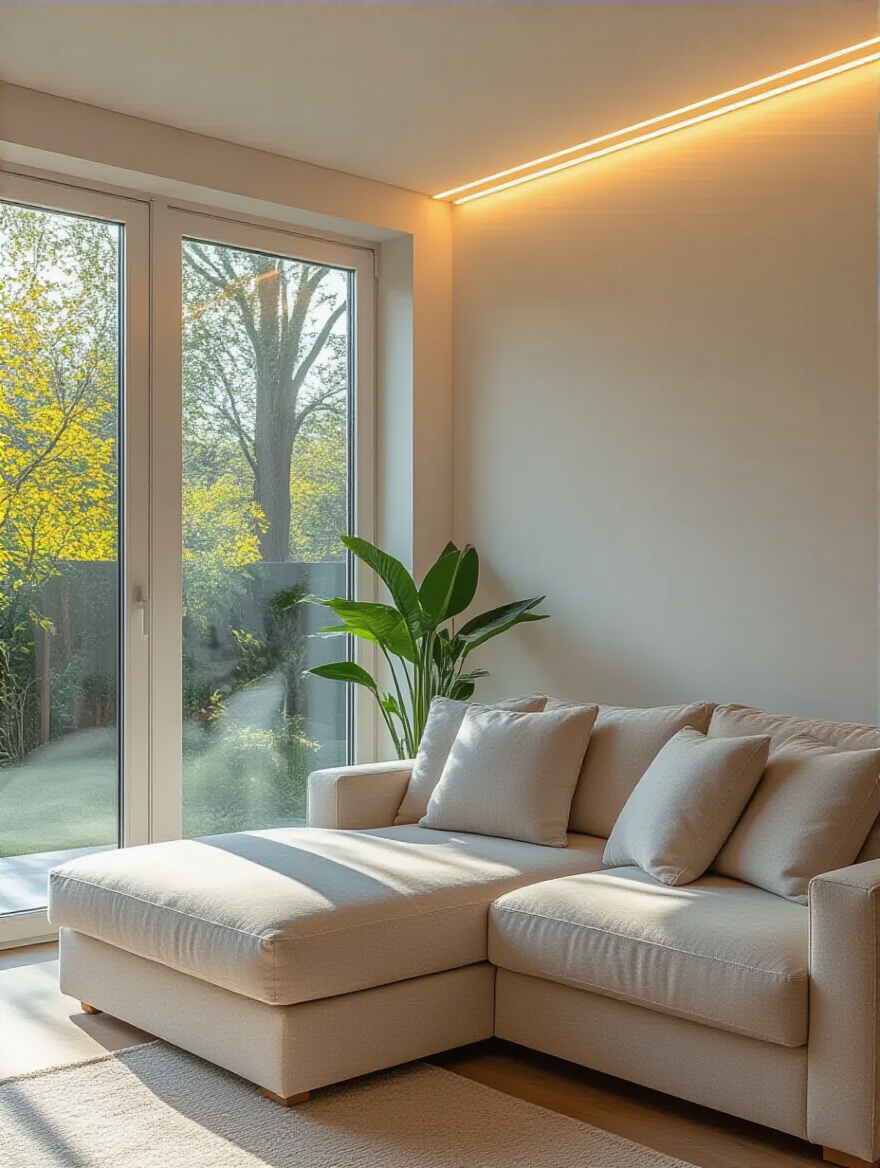
Think about how you use your living room. If it’s a space for morning coffee and reading, positioning the couch to catch the bright, blue-spectrum light from an east-facing window can help you feel more alert and energized. For evenings, however, the goal is to wind down. Here, you’d want to avoid direct light from screens or harsh overheads, instead relying on warm, dim ambient light that signals to your body it’s time to produce melatonin for restorative sleep. By orchestrating your daily light exposure, your couch becomes an active partner in your well-being, promoting better sleep, sharper focus, and a deeper sense of calm.
The Art of Conscientious Selection: Materiality, Durability, and Subtractive Health (Part 1)
Curating a nourishing space means choosing each element with intention. Here, we delve into the materials that form our living room couch, focusing on how our choices can support not only our planet but also our personal health through a “subtractive” approach—mindfully removing what doesn’t serve us.
6. Prioritizing Low-VOC and Greenguard Certified Textiles: Mitigating Indoor Air Pollutant Exposure
One of the most significant impacts we can have on our home’s health is to improve its air quality. Many conventional furniture pieces off-gas Volatile Organic Compounds (VOCs) from foams, glues, and fabric treatments. These invisible chemicals can contribute to everything from allergies to headaches. A “subtractive health” philosophy means we actively choose to remove these potential stressors from our environment.
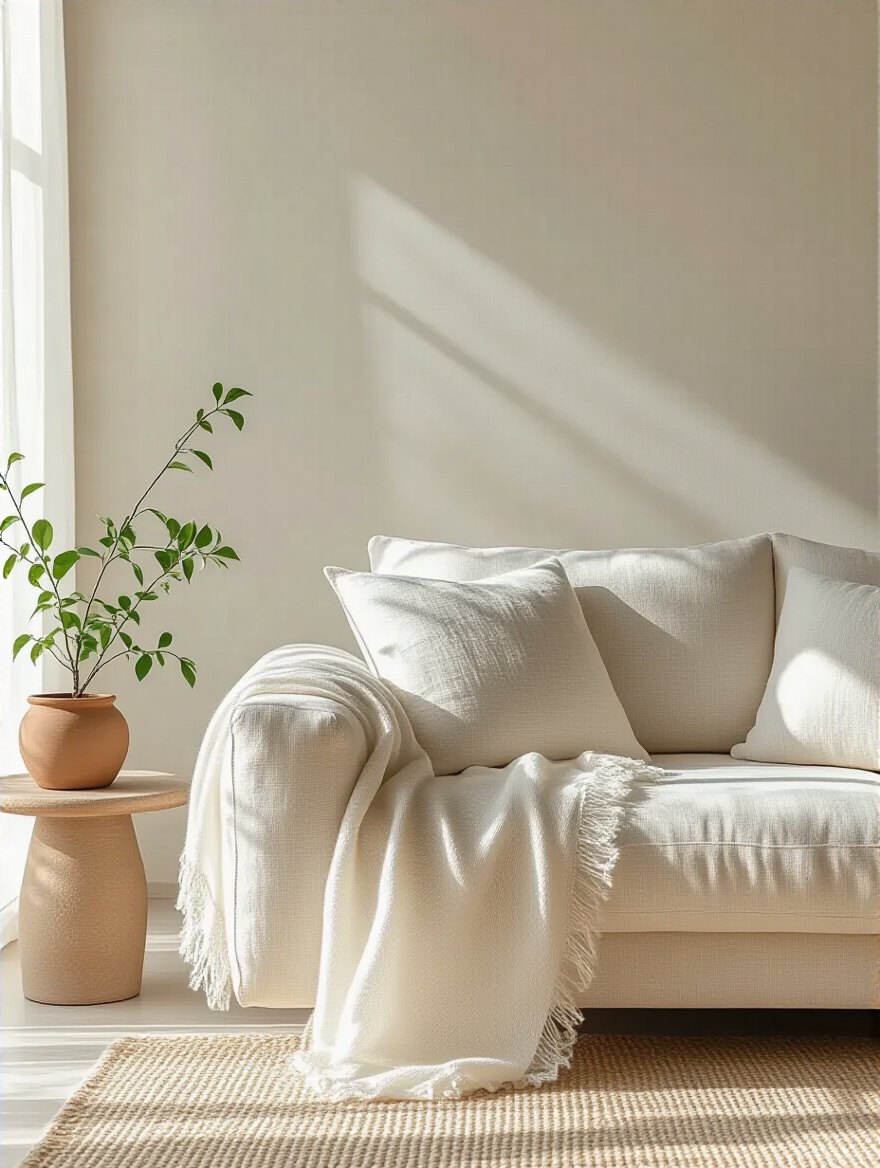
When selecting your living room couch, seek out textiles and materials with certifications like GREENGUARD Gold, which ensures products meet stringent chemical emissions standards. Oeko-Tex Standard 100 is another excellent one to look for, as it guarantees fabrics are free from a long list of harmful substances. Natural fibers like organic cotton, linen, hemp, and untreated wool are inherently better choices. What really gets me is how this simple choice can shift the entire feeling of a room. Knowing that the air you breathe is cleaner creates a profound sense of psychological peace, turning your central comfort zone into a true bastion of well-being.
7. Evaluating Inherent Material Longevity: Distinguishing Performance Fabrics from Planned Obsolescence
Mindful consumption is deeply linked to durability. A truly sustainable choice is one that endures, defying the culture of disposability. Investing in a living room couch built to last is an act of respect for resources, for craftsmanship, and for your own home. It’s about choosing a steadfast companion rather than a temporary fixture.
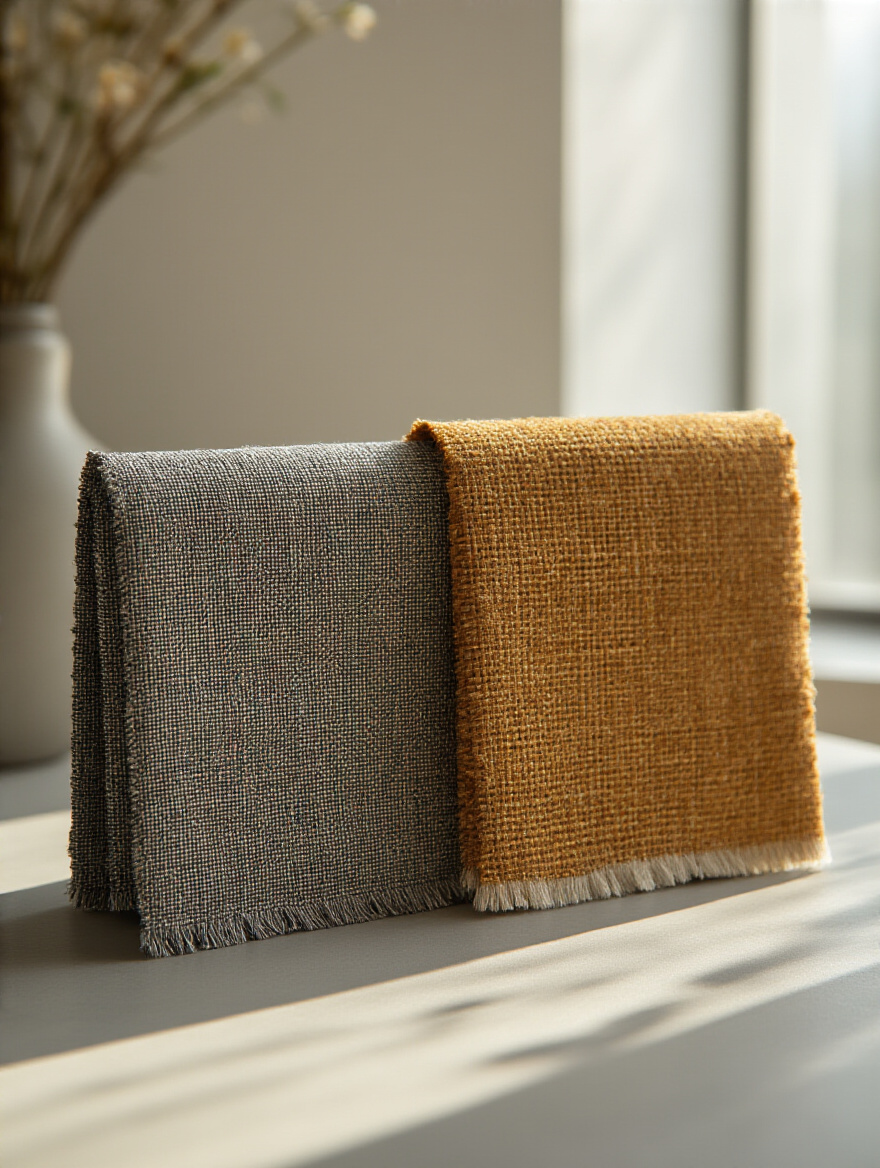
To do this, you have to look beyond surface appearances. Learn to read the metrics. Look for the “rub count” (measured in Martindale or Wyzenbeek units), which indicates abrasion resistance; anything over 20,000 is good for general home use. Pilling resistance, usually rated on a scale of 1 to 5, is also crucial for maintaining the fabric’s appearance over time. This approach allows you to choose a piece that accumulates memories and stories, one that can be loved for years—maybe even reupholstered a decade from now—instead of being sent to a landfill.
8. Dissecting Cushion Core Compositions: The Synergy of Density, Resilience, and Non-Toxic Fillings
What lies beneath the fabric is the true engine of comfort and health. The composition of your couch’s cushions affects not only how it feels but also the air you breathe. A holistic approach demands we investigate these inner components with as much rigor as the outer upholstery, seeking a synergy of supportive density, lasting resilience, and non-toxic materials.
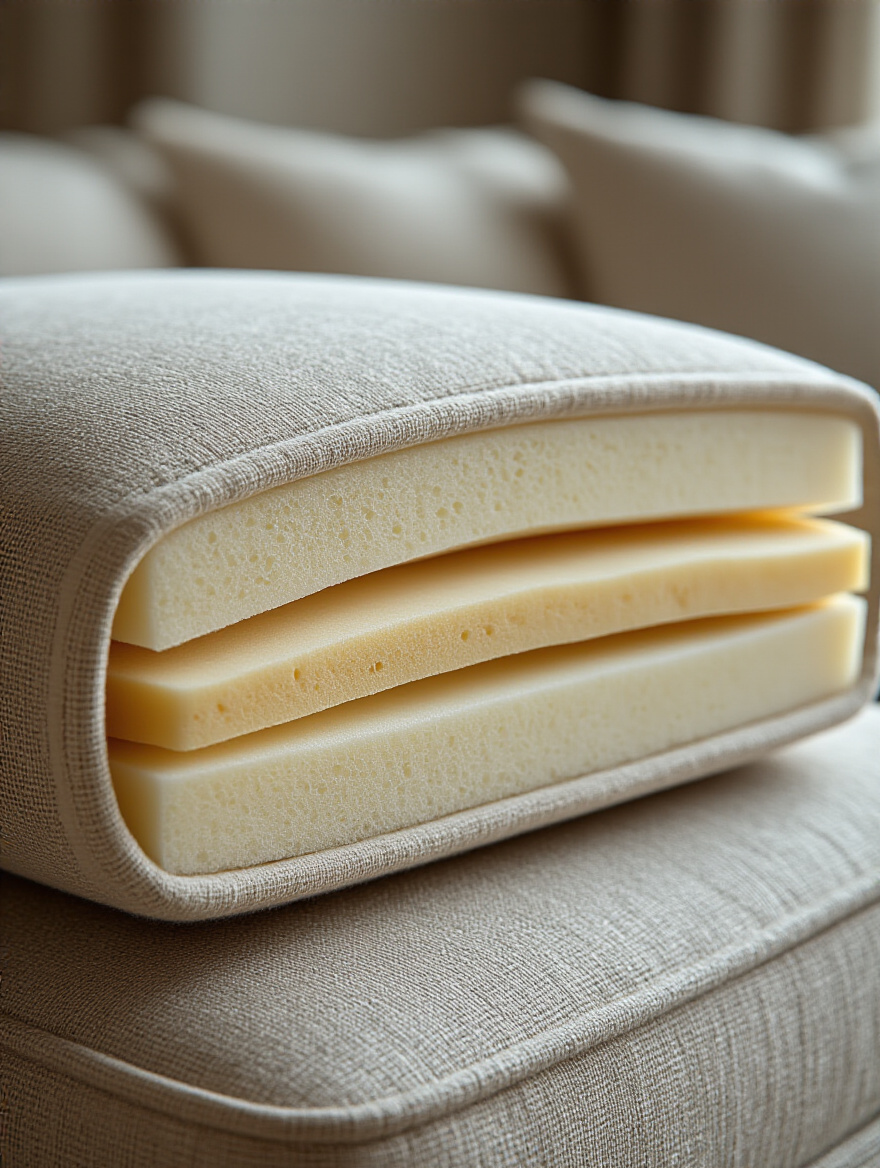
For foam, look for CertiPUR-US® certification, which ensures it’s made without a host of harmful chemicals and has low VOC emissions. High-density foam (1.8 lbs/cu ft or higher) will resist sagging far longer than lower-quality alternatives. Natural latex is another excellent choice—it’s durable, hypoallergenic, and derived from rubber trees. I learned this when working on a nursery for a family with severe allergies; choosing natural latex for their seating made a tangible difference. Making an empowered choice about these unseen materials ensures your living room couch is a source of pure comfort, both inside and out.
9. Assessing Frame Structural Integrity: Delineating Sustainably Sourced Hardwoods and Joinery Methodologies
A couch’s silent strength—its very promise of longevity—comes from its frame. This is the skeleton upon which all comfort and beauty are built. A top-tier frame is constructed from kiln-dried solid hardwood, like maple, oak, or ash. Kiln-drying removes moisture to prevent warping and cracking over time. Steer clear of frames made from softwoods or particleboard held together with staples, as they simply won’t last.
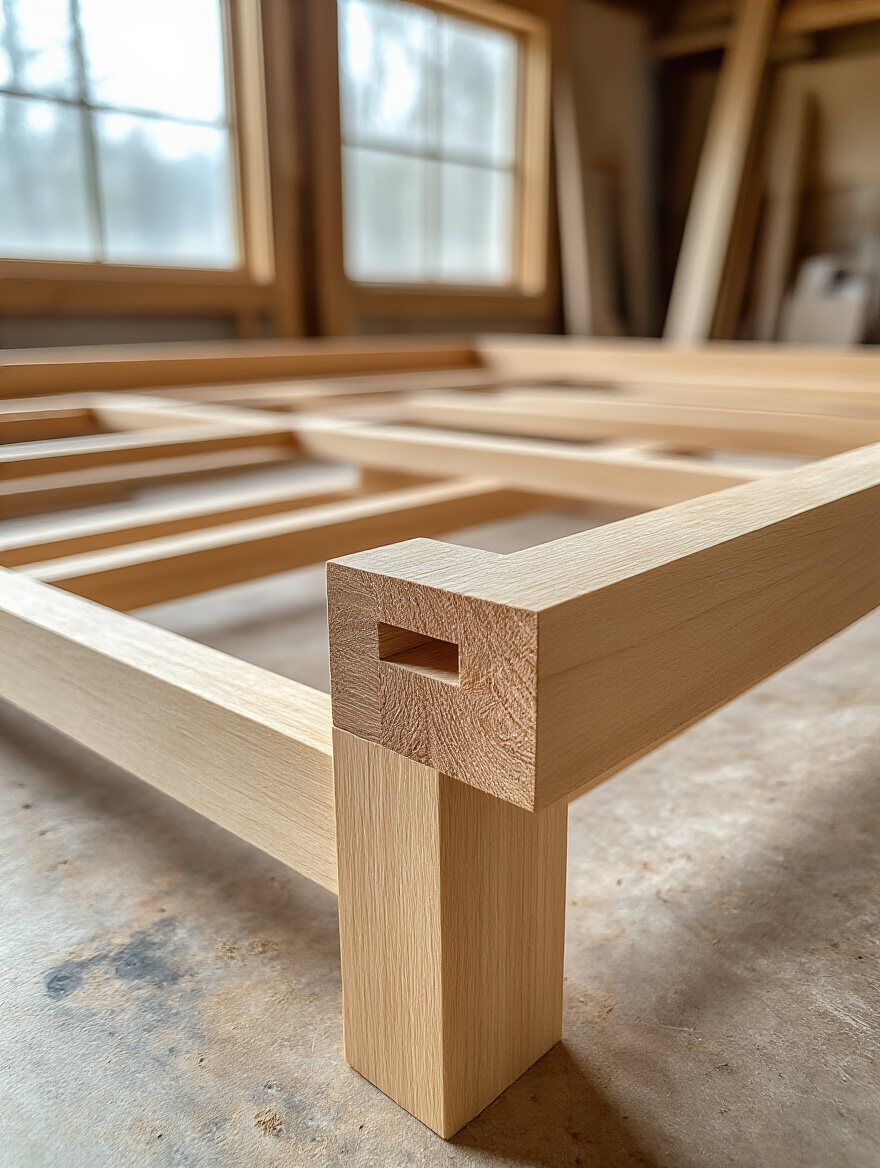
The joinery method is just as critical. Look for interlocking techniques like mortise-and-tenon or dowel joints, reinforced with corner blocks that are both glued and screwed. In my professional experience, a well-built frame is what separates an heirloom piece from one destined for the curb in five years. By choosing a frame made from FSC-certified wood, you’re also making a commitment to responsible forestry. This choice provides the unspoken assurance that the anchor of your living space is built with integrity, ready to offer steadfast comfort for decades.
The Art of Conscientious Selection: Materiality, Durability, and Subtractive Health (Part 2)
We continue our journey into mindful selection, focusing on how specific material choices can create a healthier environment. This is about being proactive, using design as a tool to mitigate potential allergens and ensure your sanctuary remains both beautiful and functional for years to come.
10. Exploring Hypoallergenic Fabric Alternatives: Mitigating Allergic Sensitivities Through Intelligent Specification
For many of us, creating a healthy home means actively designing against allergens. Your living room couch, with its vast surface area, can be a major reservoir for dust mites, pet dander, and other irritants. Choosing hypoallergenic fabrics is a powerful act of subtractive health, removing potential triggers from your most-used piece of furniture.
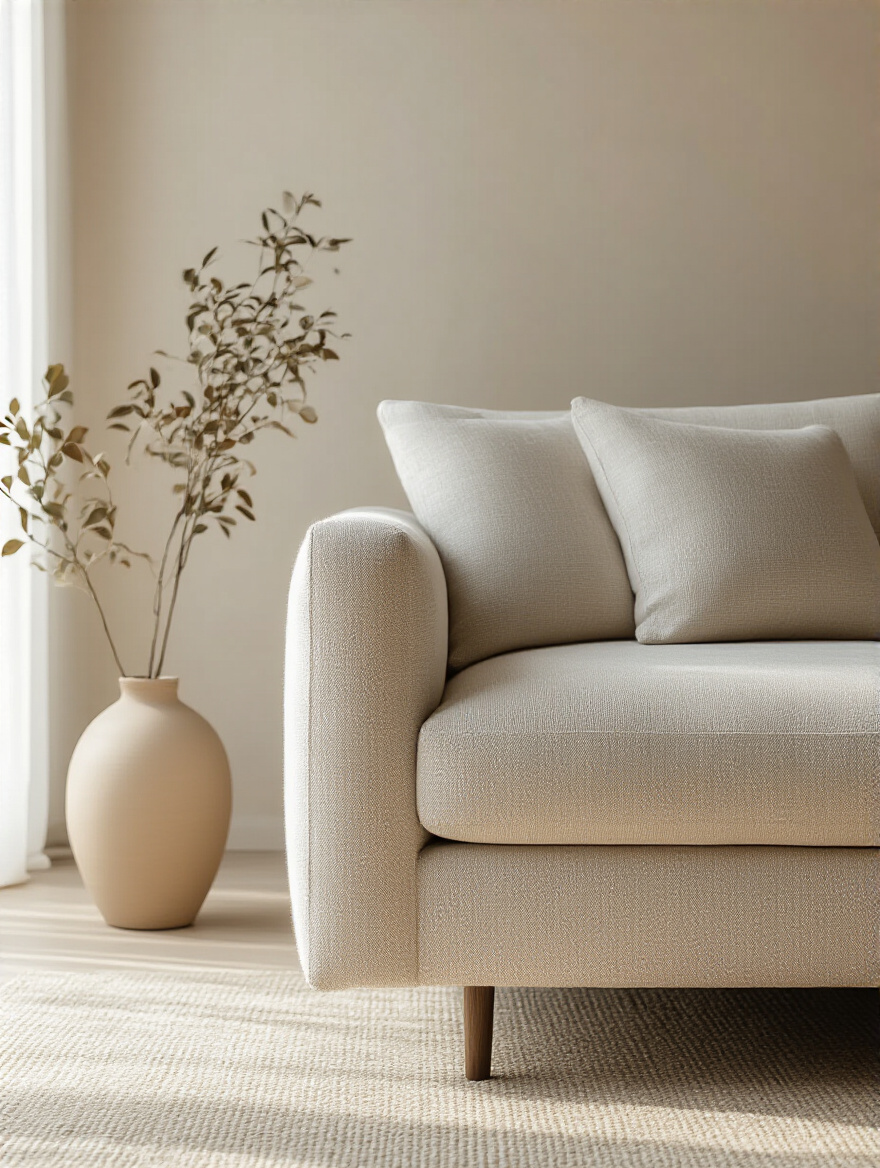
Natural fibers like organic cotton, linen, and hemp are excellent choices, as is wool for its natural resistance to mold and mildew. If you prefer synthetics, look for tightly woven microfibers specifically designed to prevent allergen penetration. Years of mindful space planning have taught me that these choices are not just for those with diagnosed allergies; they contribute to cleaner indoor air quality for everyone, supporting clearer respiratory function and an overall sense of ease. It transforms your couch from a simple furnishing into a proactive tool for a healthier life.
11. Decoding Fabric Rub Counts and Pilling Resistance: Predictive Metrics for Aesthetic and Functional Wear
The philosophy of mindful living embraces an appreciation for things that last. When it comes to your living room couch, fabric durability isn’t just a practical matter; it’s a commitment to sustainability. Two key metrics can help you predict how well a fabric will hold up over time: rub counts and pilling resistance. These aren’t just industry jargon; they are your tools for making a wise, long-term investment.
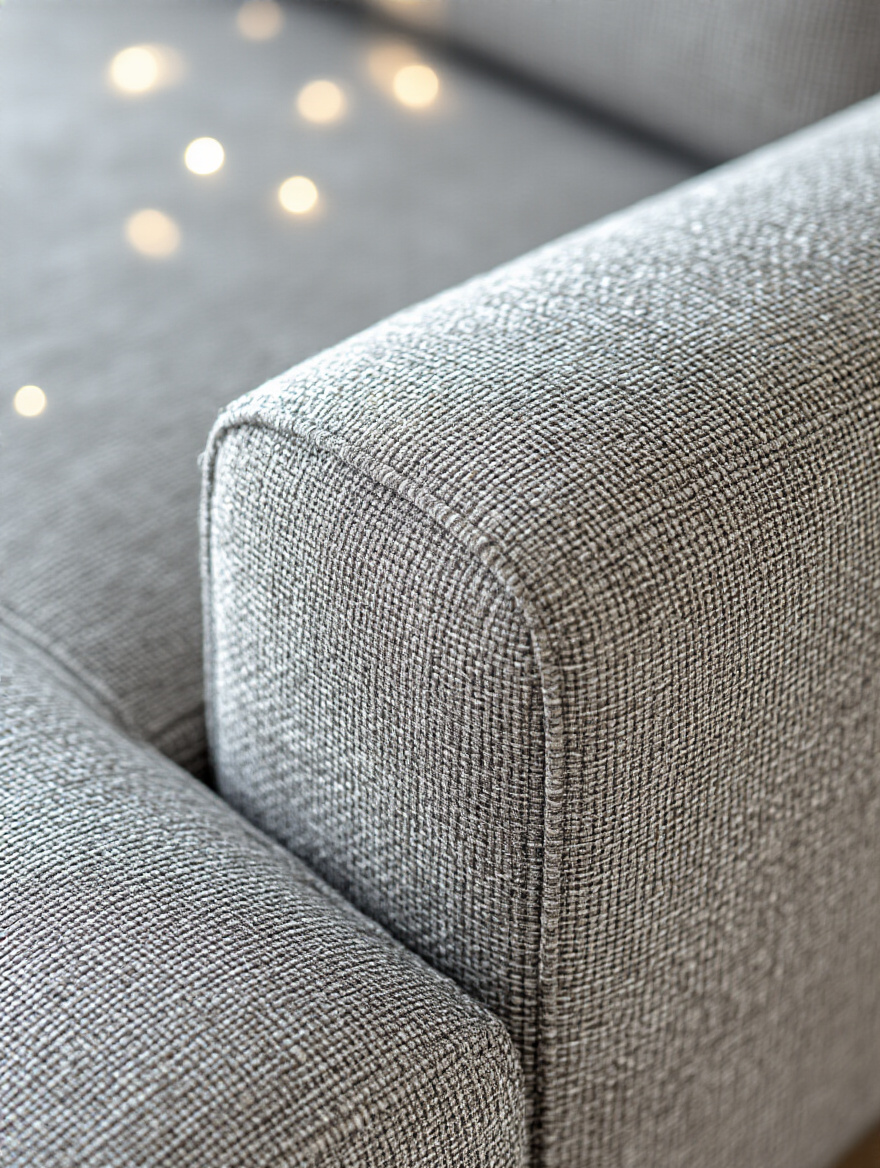
The “rub count” measures abrasion resistance—for a busy family home, I recommend looking for at least 25,000 double rubs. Pilling, those little balls of fiber that form on a fabric’s surface, is rated on a scale of 1 to 5 (with 5 being the best). Choosing a fabric with high ratings on both fronts means your couch will maintain its beauty and integrity for years, reducing waste and fostering a stable, calming environment. It’s a choice that reflects a deeper value for enduring quality over fleeting trends.
12. Integrating Multi-Functionality for Evolving Spatial Dynamics: The Convertible and Modular Design Paradigm
Our lives are fluid, and our homes should be able to adapt with us. This is where multi-functional and modular design becomes a key principle of wellness architecture. An adaptable living room couch can transform to meet your needs, whether you’re hosting overnight guests in a small apartment or reconfiguring your space for a family movie night versus an intimate conversation.
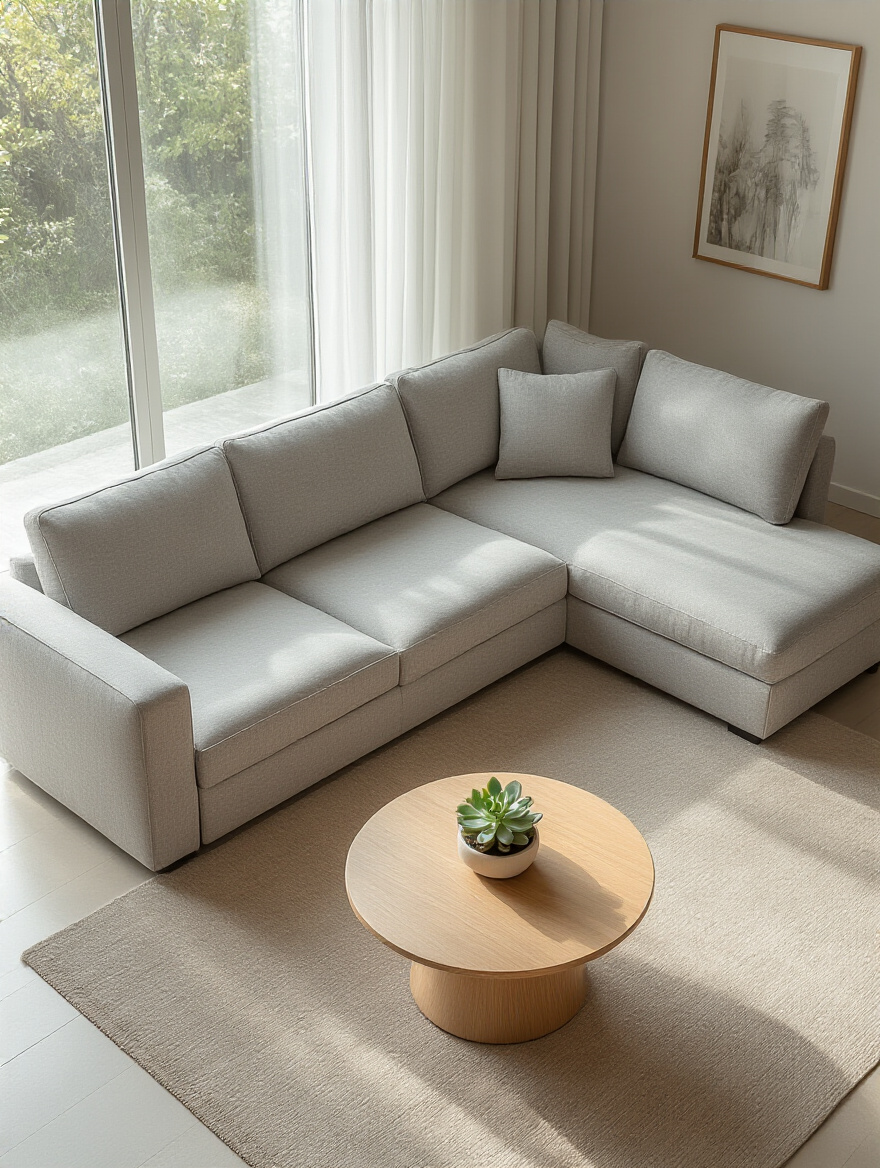
Modular systems, composed of individual sections, offer the ultimate flexibility. They can be reconfigured to suit different occasions, optimizing traffic flow and social dynamics without needing to buy new furniture. This approach empowers you to be an active participant in shaping your environment. A modular living room couch isn’t just a piece of furniture; it’s a responsive element in your home’s story, ensuring your space always feels perfectly aligned with your life, right now.
Harmonious Integration: Activating Spaces Through Mindful Placement
Once you’ve chosen the perfect piece, its placement is what truly activates its potential. Mindful arrangement can orchestrate the flow of energy, enhance visual calm, and turn a simple room into a truly harmonious haven.
13. Orchestrating Energy Flow: Applying Feng Shui Principles for Commanding Couch Placement
The ancient art of Feng Shui offers profound wisdom about how the placement of objects affects the flow of energy, or Ch’i, in a space. You don’t have to be a master to apply its core principles. For a living room couch, the goal is to create a “command position”—an arrangement that feels secure, supportive, and in control.
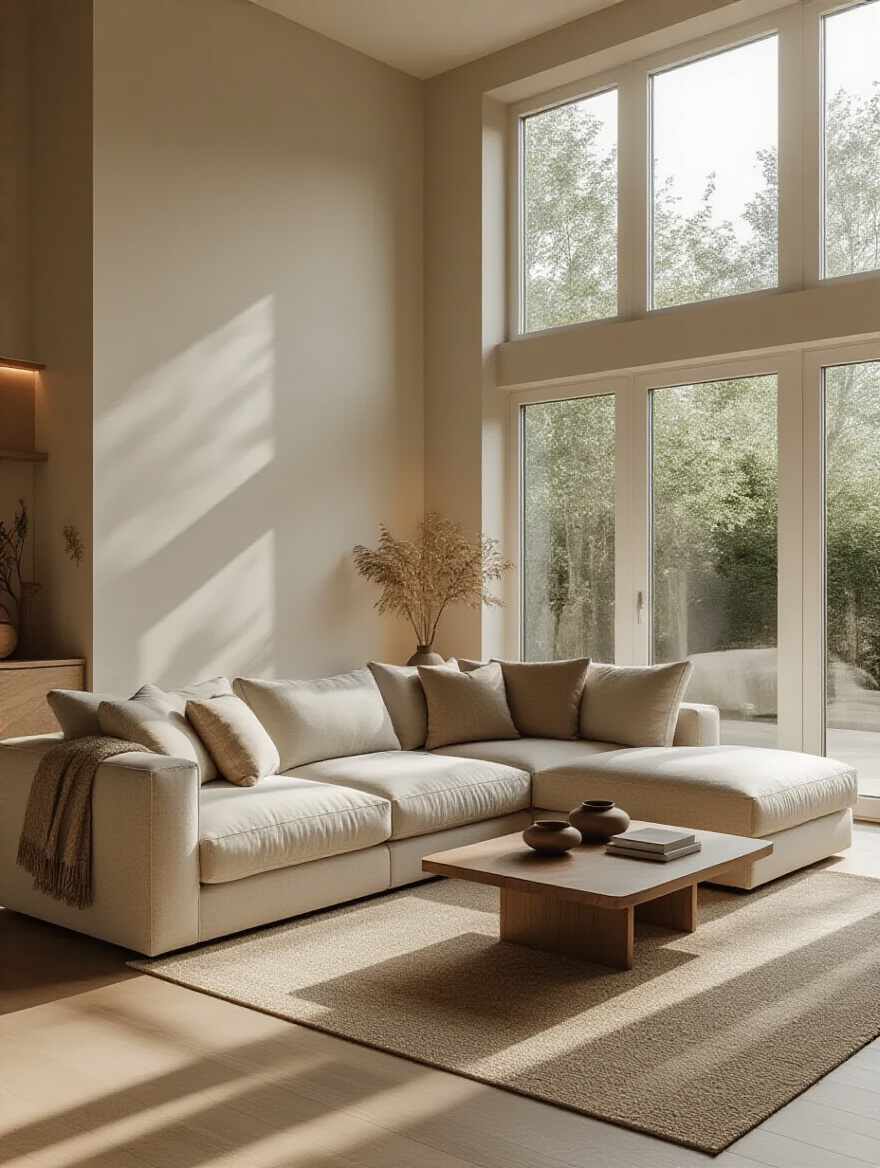
Practically, this means placing your couch against a solid wall. This provides a sense of subconscious stability and protection. From this spot, you should have a clear view of the room’s main entrance without being directly in line with it. This allows you to feel relaxed and at ease, rather than subconsciously vigilant. I’ve seen this play out when a simple repositioning of a couch has completely changed the feeling of a room, making it more welcoming and peaceful for the entire family.
14. Cultivating Visual Respite: Strategically Positioning to Maximize Uninterrupted Sightlines and Vista Access
Our brains are wired to appreciate open perspectives and clear sightlines; it’s an instinct tied to our sense of safety and calm. Your living room couch should serve as a beautiful vantage point, a place from which your eye can travel without interruption. This practice of cultivating visual respite is a powerful tool for reducing cognitive load and fostering mental freedom.
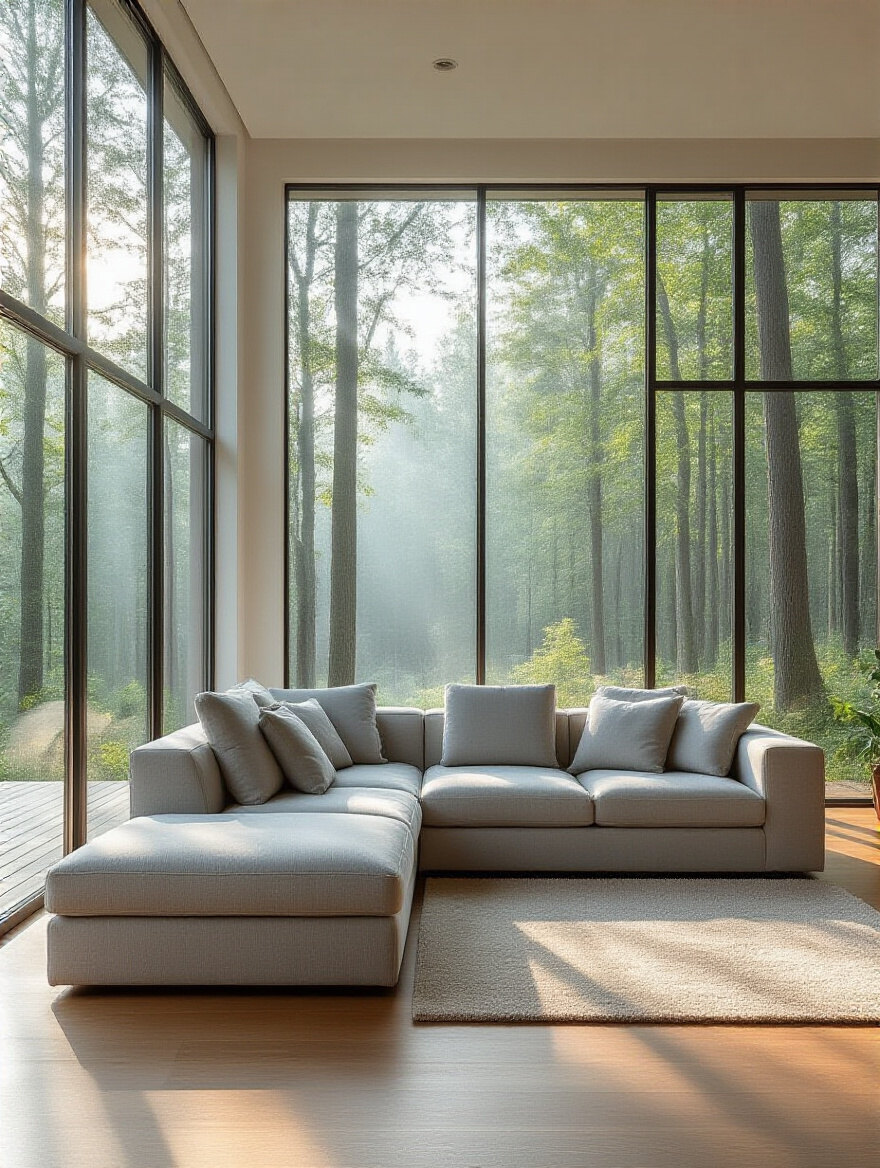
Position your couch to take advantage of the best view—whether that’s a window looking out onto a garden or an internal focal point like a beautiful piece of art or a fireplace. Keep the pathways around it clear to create a sense of openness. This isn’t just about aesthetics; it’s about creating an environment where your mind can breathe. A well-placed living room couch invites you to unwind fully, knowing that your gaze can rest on something expansive and beautiful.
15. Crafting Micro-Environments: Designing Intentional Vignettes with Supportive Accessories
A truly nurturing space offers layers of experience. Around your central living room couch, you can craft “micro-environments”—small, intentional vignettes designed for specific activities like reading, conversation, or quiet contemplation. This is the heart of concepts like hygge, the Danish art of creating cozy contentment. It’s about turning a general seating area into a multifaceted haven.
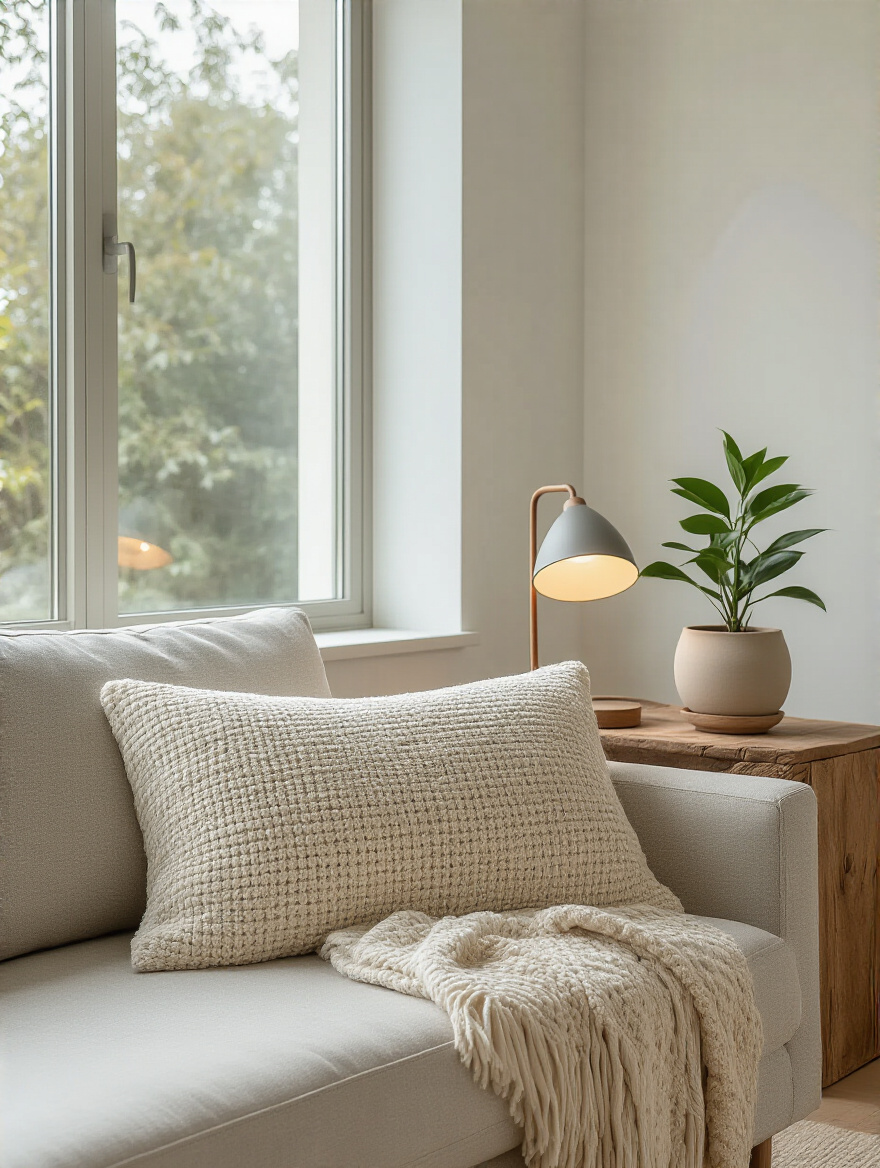
This is where you bring in the supportive accessories. A beautifully designed floor lamp with warm light creates a perfect reading nook. A small side table holds a cup of tea and a good book. A luxurious throw invites you to curl up. These aren’t just decorations; they are functional tools for well-being, placed with intention. This thoughtful layering transforms passive lounging into an active, mindful engagement with your surroundings, making you feel truly at home.
16. Mitigating Acoustic Reverberation: Employing Textiles and Strategic Layout for Sonic Comfort
True tranquility is multi-sensory. An often-overlooked aspect of a calming home is its acoustics. Rooms with lots of hard surfaces can create harsh echoes and reverberations, leading to a subtle sense of stress and sensory overload. A peaceful home has a gentle quiet, not a chaotic hum.
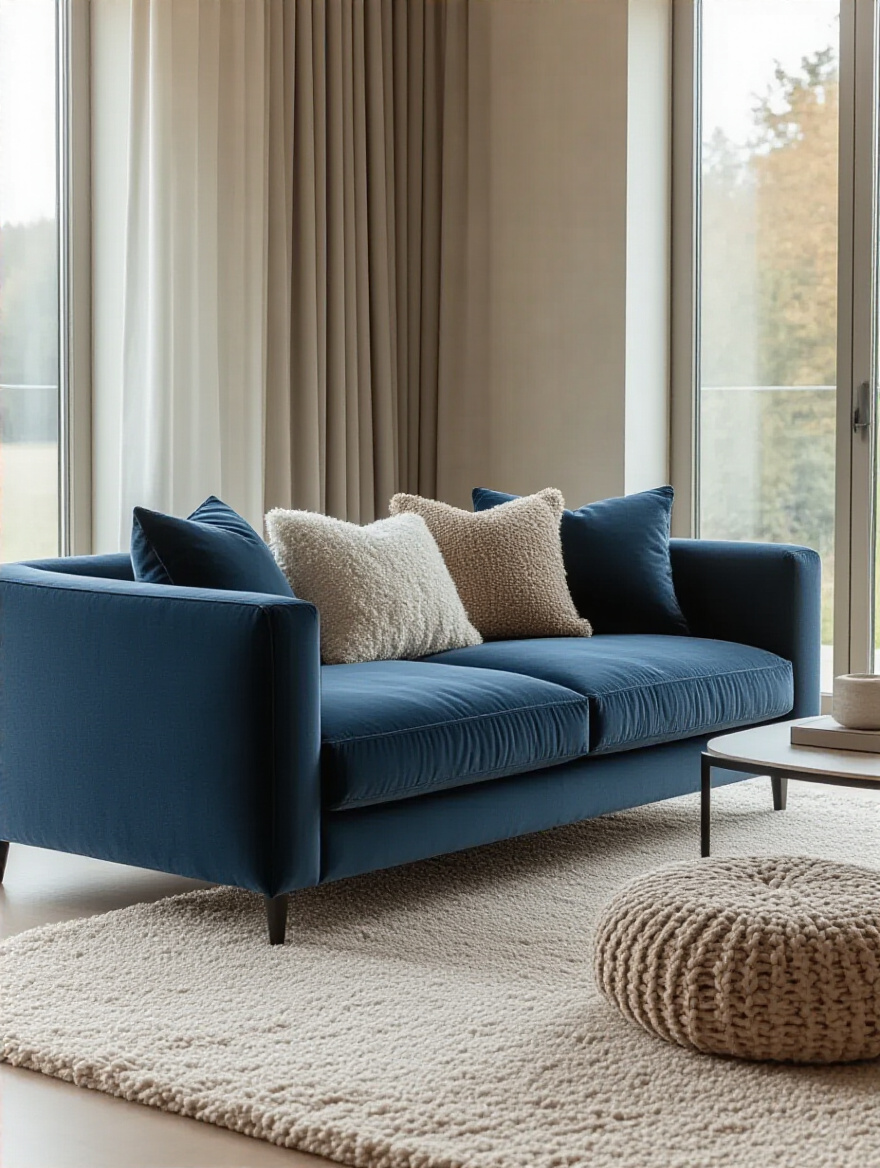
Your living room couch is one of your best tools for improving sonic comfort. Its upholstered form naturally absorbs sound. You can enhance this effect by layering other textiles: a plush rug underfoot, heavy drapes on the windows, and an abundance of throw pillows. Strategically placing your couch to break up large, parallel walls can also diffuse sound waves, making conversation clearer and silence more profound. Designing for auditory serenity is a sophisticated layer of wellness design that makes a remarkable difference.
Sustaining the Sanctuary: Proactive Care and Evolutionary Adaptations
A truly mindful home is not a static picture; it’s a living, evolving space. Embracing a philosophy of stewardship for your cherished pieces ensures they grow gracefully with you, continuing to provide comfort and serenity for years to come.
17. Establishing Proactive Upholstery Care Regimens: Advanced Stain Resistance and Preventative Maintenance Protocols
The philosophy of mindful living extends to how we care for our possessions. A proactive care regimen for your living room couch is a ritual that safeguards its beauty and integrity. It starts with understanding your fabric’s specific needs. But you can go a step further by choosing fabrics with high-performance, non-toxic treatments that repel spills before they can set.
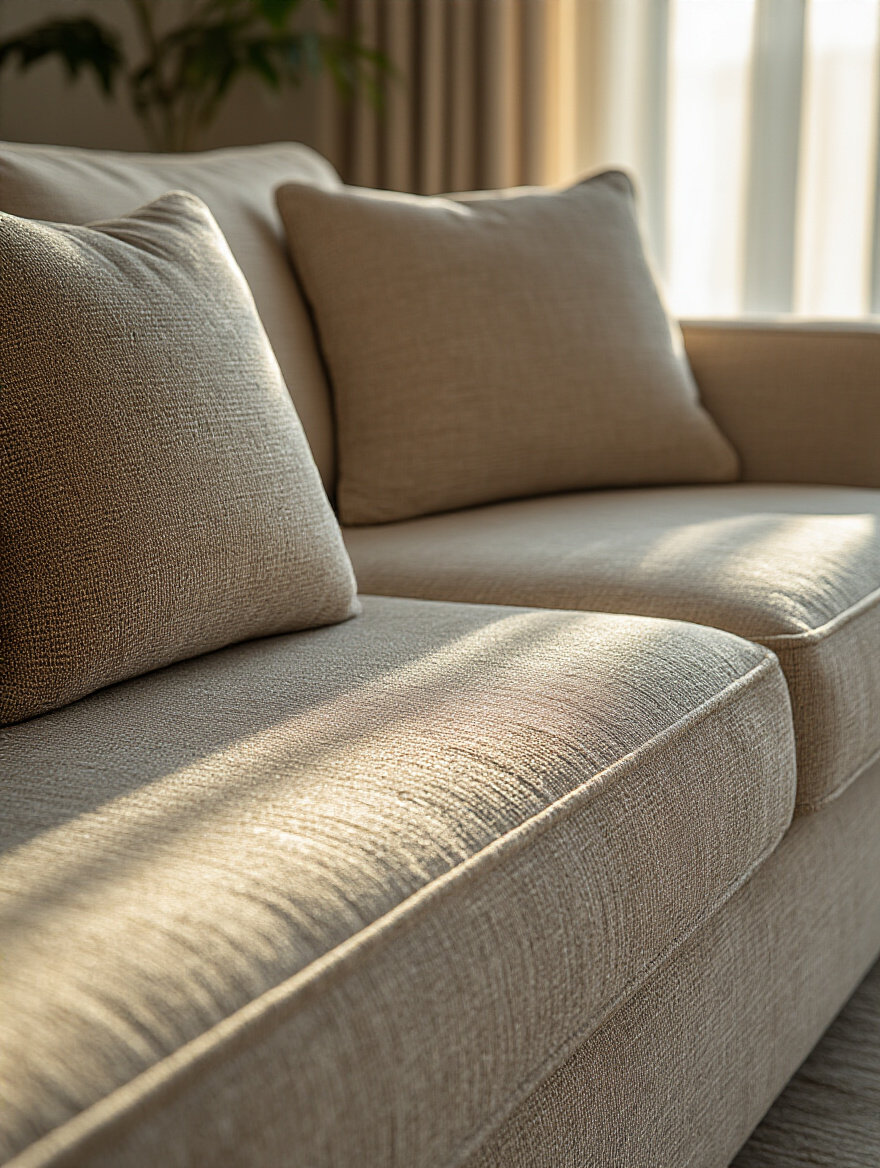
Preventative maintenance is a form of meditation. A weekly, gentle vacuuming with a soft brush attachment removes abrasive dust particles that accelerate wear. Positioning the couch away from direct, harsh sunlight prevents fading. By turning care into a conscious practice rather than a reactive chore, you reinforce a sense of order and respect within your sanctuary, ensuring its beauty endures.
18. Mastering the Art of Cushion Rotation: Ensuring Uniform Wear and Prolonging Core Structural Integrity
The simple act of rotating your cushions is fundamental to preserving the comfort and silhouette of your living room couch over time. It’s a practice of equilibrium, ensuring that wear is distributed evenly. We all have our favorite spot, but concentrating wear in one area will inevitably lead to sagging and degradation.
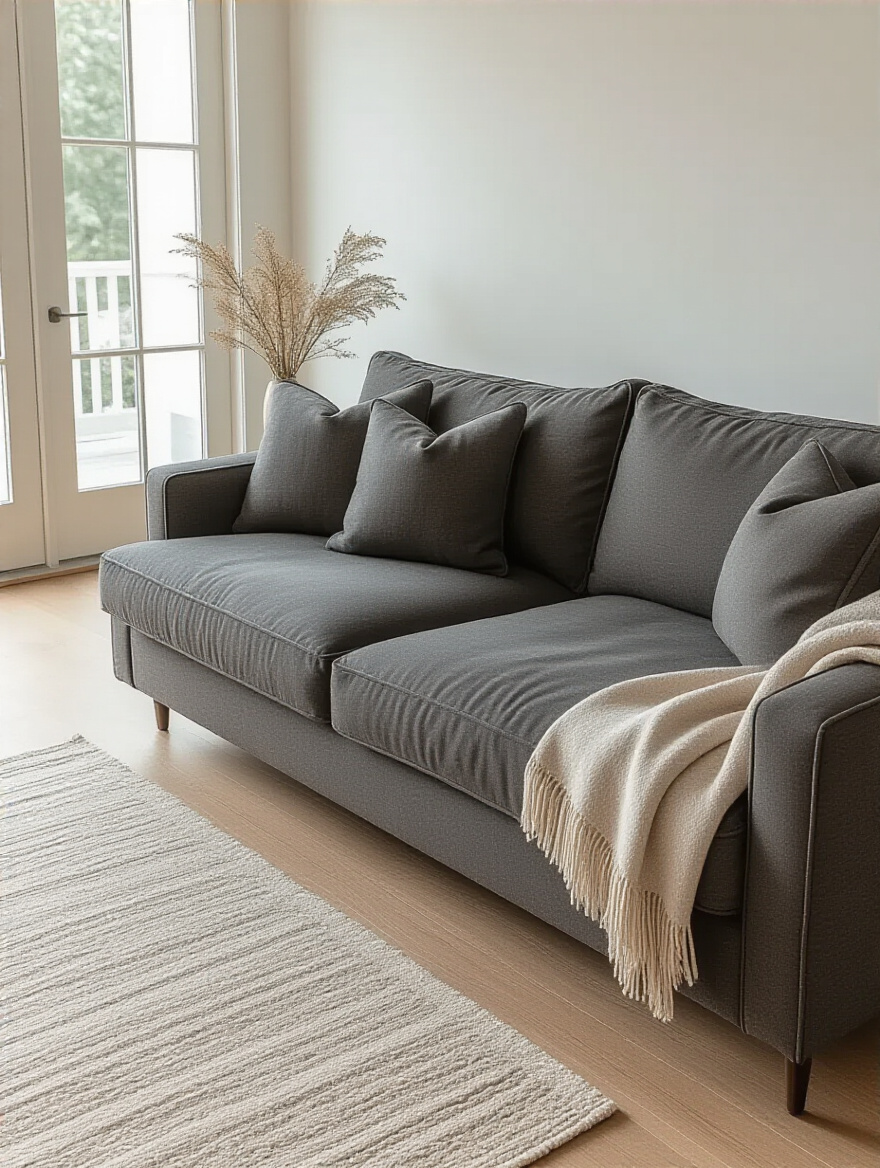
Create a simple rhythm for this. Every few weeks, flip, rotate, and even swap the seat and back cushions. This allows the internal foam or down to decompress and rebound, maintaining its supportive loft. This small, mindful act is an empathetic gesture toward your furniture, an acknowledgment that true comfort is something we must actively nurture. It’s a testament to mindful living that keeps your couch feeling perpetually new and inviting.
19. Adaptive Reconfiguration: Evaluating Modular Options for Evolving Life Stages and Spatial Requirements
The one constant in life is change. A home that supports our well-being should be able to adapt with us. Modular sofas embody this principle of fluidity, transforming a static object into a dynamic element that can evolve with your life’s needs. A modular living room couch is a wise investment in your future flexibility.
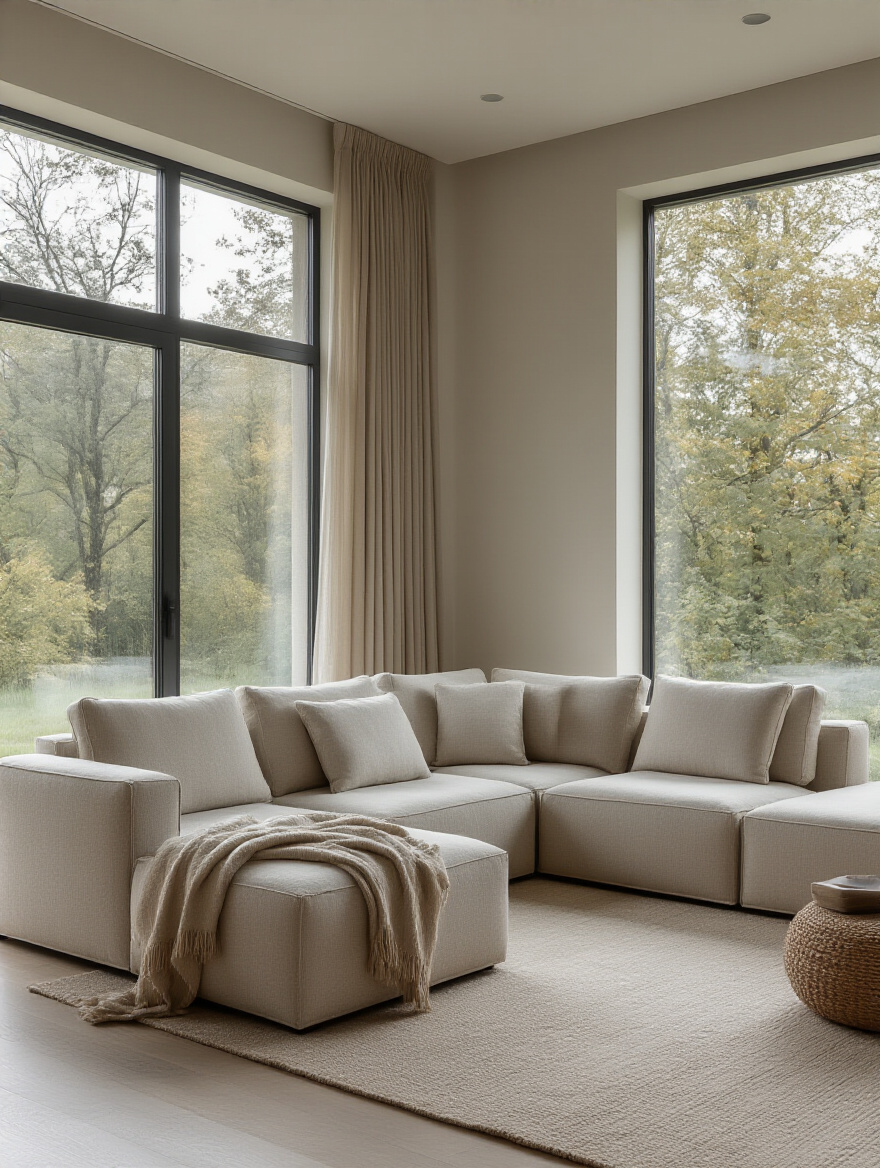
Imagine a couch that can reconfigure from a large sectional for family movie night to two separate loveseats for a party, or an L-shape that perfectly frames a new fireplace. This adaptability empowers you to continuously optimize your space as your family grows, your needs change, or you simply crave a fresh perspective. It ensures your sanctuary is always perfectly aligned with your life.
20. Infusing Tactile Narratives: Curating Throws and Pillows for Multi-Sensory Comfort and Personal Expression
The final layer of comfort is deeply personal and sensory. Throws and pillows are not mere afterthoughts; they are the tactile narratives that make a house a home. They invite touch, offer adaptable support, and provide a canvas for personal expression through color, pattern, and texture. This is how you infuse your unique story into your space.
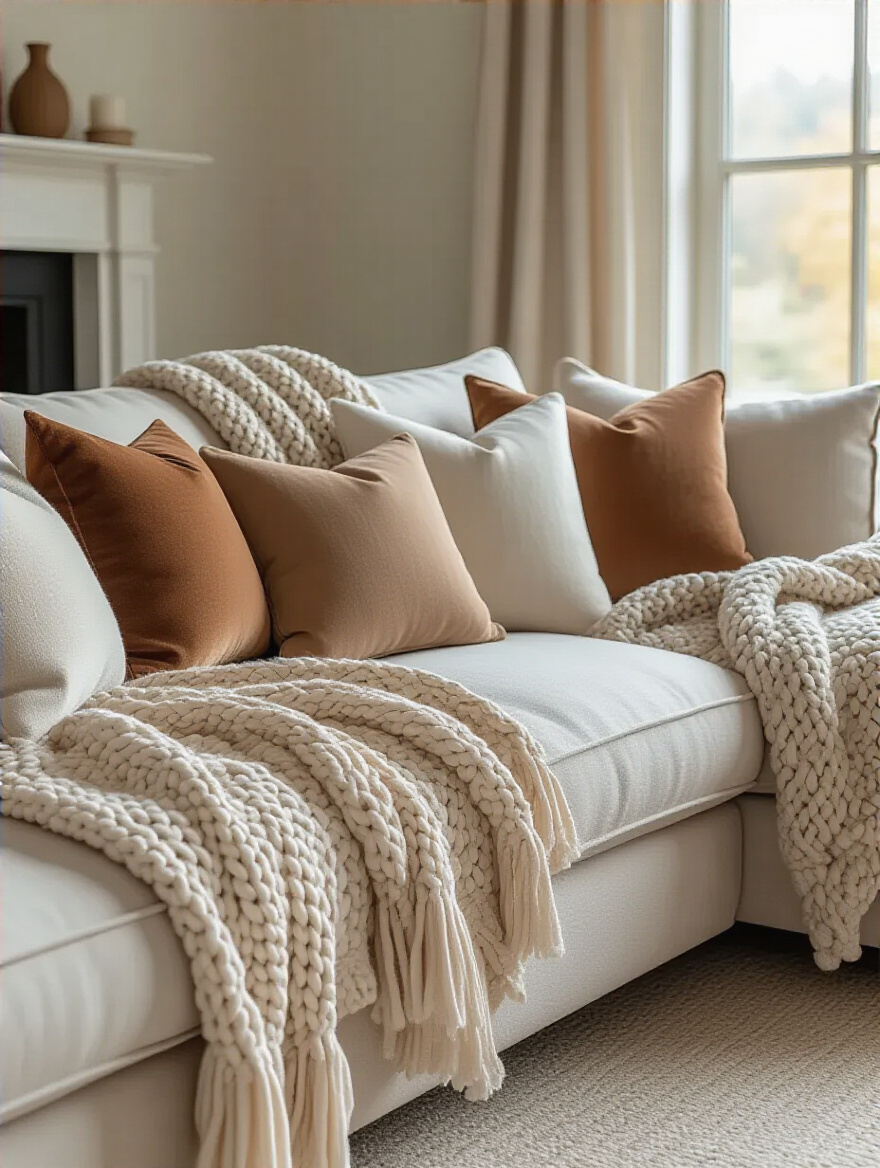
Explore a rich palette of materials: the warmth of merino wool, the cool crispness of linen, the plushness of velvet. Contrast smooth textures with nubbly ones. I always tell my clients that arranging these elements is an ongoing creative conversation with your home. You can shift the mood of your living room couch with the seasons or simply your own state of mind, reinforcing the profound connection between your inner world and the nurturing space you have so thoughtfully created.
Conclusion
Across these twenty considerations, we have journeyed far beyond the typical conversation about choosing furniture. We have reframed the selection of a living room couch as a profound act of self-care—an opportunity to build a foundation for well-being right in the heart of your home. From the ergonomic science that supports your body to the non-toxic materials that protect it, every choice is a chance to align your environment with your deepest values.
The goal is not to achieve a state of static perfection, but to create a responsive, nurturing sanctuary that supports you through all of life’s moments. The principles of biophilia, circadian alignment, and mindful materialism are not abstract ideals; they are practical tools you can use to curate a space that feels deeply and authentically yours. May your living room couch be more than just a place to sit; may it be a testament to your commitment to a life lived with intention, harmony, and grace.
